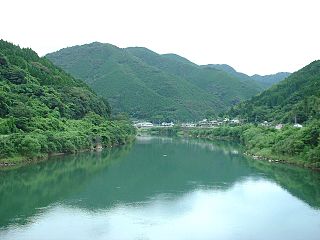
A dam is a barrier that stops or restricts the flow of surface water or underground streams. Reservoirs created by dams not only suppress floods but also provide water for activities such as irrigation, human consumption, industrial use, aquaculture, and navigability. Hydropower is often used in conjunction with dams to generate electricity. A dam can also be used to collect or store water which can be evenly distributed between locations. Dams generally serve the primary purpose of retaining water, while other structures such as floodgates or levees are used to manage or prevent water flow into specific land regions. The earliest known dam is the Jawa Dam in Jordan, dating to 3,000 BC.

Shitara is a town located in Kitashitara District, Aichi Prefecture, Japan. As of 1 October 2019, the town had an estimated population of 4,531 in 2,133 households, and a population density of 16.5 persons per km². The total area of the town was 273.94 square kilometres (105.77 sq mi).

Toyone is a village located in Kitashitara District, Aichi Prefecture, Japan. As of 1 October 2019, the village had an estimated population of 1,031 in 507 households, and a population density of 6.61 persons per km². The total area of the village was 155.88 square kilometres (60.19 sq mi).

Kitashitara District is a rural district located in northeastern Aichi Prefecture, Japan.
The Gold Coast Marathon is an annual road marathon on the Gold Coast, Queensland, Australia, first held in 1979. Marketed as "Australia's premier road race", the marathon is the only race in Australia to hold World Athletics Label status. The marathon is held on the first Sunday of July each year, with other races held the day before.

The Kuma River is a river in Kumamoto Prefecture, central Western part of Kyūshū, Japan. It is sometimes referred as Kumagawa River. It is the longest river in Kyushu, with the length of 115 km long and has a drainage area of 1,880 km2 (730 sq mi). The tidal flat of the Kuma River estuary is approximately 1000 hectares.

Hello! Sandybell is an anime series made by Toei Animation in 1981. It was aired in Japan by TV Asahi.

Malampuzha Dam is the largest dam and reservoirs in Kerala, located near Palakkad, in the state of Kerala in South India, built post independence by the then Madras state. Situated in the scenic hills of the Western Ghats in the background it is a combination of a masonry dam with a length of 1,849 metres and an earthen dam with a length of 220 metres making it the longest dam in the state. The dam is 355 feet high and crosses the Malampuzha River, a tributary of Bharathappuzha, Kerala's second longest river. There is a network of two canal systems that serve the dam's reservoir of 42,090 hectares.

Lost+Brain is a Japanese manga series written by Tsuzuku Yabuno and illustrated by Akira Ōtani. It was serialized in Shogakukan's Weekly Shōnen Sunday from December 2007 to July 2008, with its chapters collected in three tankōbon volumes.
Shitara is a Japanese surname. Notable people with the surname include:

The Samanala Dam is a dam primarily used for hydroelectric power generation in Sri Lanka. Commissioned in 1992, the Samanalawewa Project is the third-largest hydroelectric scheme in the country, producing 405 GWh of energy annually. It was built with financial support from Japan and the United Kingdom. It is notable for a large leak on its right bank. Power production continues as planned despite the leakage, and the water from the leak now provides two thirds of the water issued by the reservoir for agriculture in downstream areas.

The Gōnokawa River is a river that runs through Hiroshima and Shimane prefectures in Japan. It is the largest river in the Chūgoku region. It is also called the Gōgawa River and, in Hiroshima, the Enokawa River.

The Shin-Takasegawa Pumped Storage Station (新高瀬川発電所) uses the Takase River to operate a pumped storage hydroelectric scheme about 12 kilometres (7.5 mi) west of Ōmachi in Nagano Prefecture, Japan. Part of the system is within Chūbu-Sangaku National Park.
Bananaman (バナナマン) is a Japanese owarai comedy duo consisting of Osamu Shitara and Yūki Himura.
Osamu Shitara is a Japanese comedian, actor, voice actor and television presenter. He performs boke and tells stories in the comedy duo Bananaman. His partner is Yūki Himura. He is also a former Seibu Railway employee.

Yuta Shitara is a Japanese long-distance runner. He competed in the 10,000 metres at the 2015 World Championships in Beijing finishing 23rd.

That Time I Got Reincarnated as a Slime, also known as TenSura (転スラ) or Slime Isekai, is a Japanese fantasy light novel series written by Fuse, and illustrated by Mitz Vah. The story is about a salaryman who is murdered and reincarnates in a sword and sorcery world as a slime with unique powers and gathers allies to build his own nation of monsters.

The 2018 Tokyo Marathon was the twelfth edition of the annual marathon race in Tokyo and was held on Sunday, 25 February. An IAAF Gold Label Road Race, it was the first World Marathon Majors event to be held that year. The men's race was won by Dickson Chumba in 2:05:30 hours while the women's race was won by Birhane Dibaba in 2:19:51. The men's runner-up Yuta Shitara set a Japanese national record time of 2:06:11 hours. This was also an Asian record. The host nation featured prominently in the men's race, with two runners in the top five and six of the top ten being Japanese. The Japanese women fared less well, with sixth-place Hiroko Yoshitomi being the best national performer.

That Time I Got Reincarnated as a Slime is a 2018 television anime series based on the light novel series written by Fuse. The series follows a man who is killed and reincarnated in another world as a slime named Rimuru. The series is animated by Eight Bit with the staff and cast members reprising their roles. The second season has been announced to be split-cour anime, and the first half scheduled to premiere in October 2020 but has been delayed to January 2021 due to COVID-19. The second half was also delayed from April 2021 to July 2021. The first half aired from January 12 to March 30, 2021, while the second half aired from July 6 to September 21, 2021. The opening theme is "Storyteller" performed by TRUE, and the ending theme is "STORYSEEKER" performed by STEREO DIVE FOUNDATION. The second opening theme is "Like Flames" performed by MindaRyn, and the second ending theme is "Reincarnate" performed by Takuma Terashima. The anime is streaming in Asia through Muse Asia YouTube Channel.















